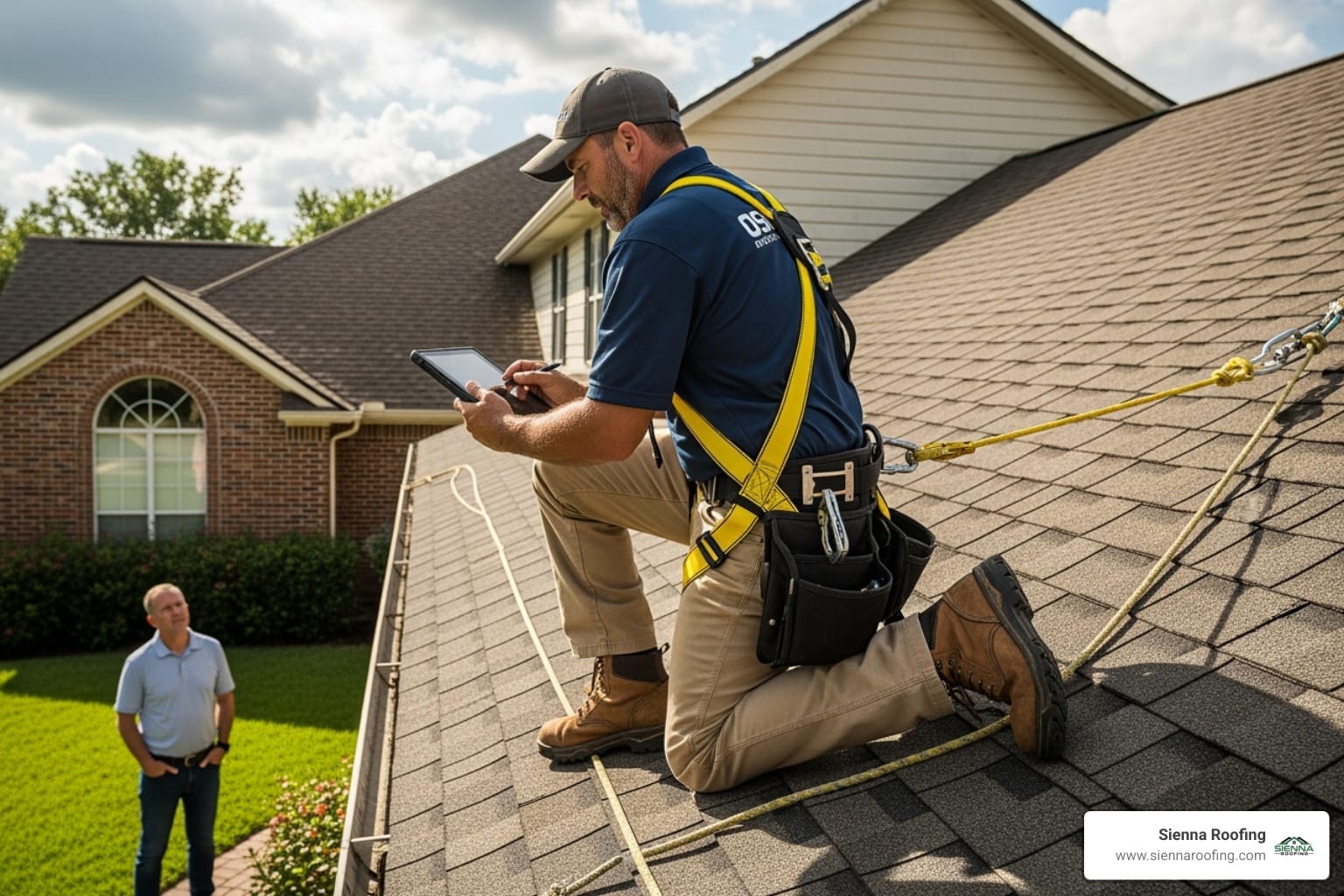Roof Estimate Cost: Get the Best for 2025
Why Understanding Roof Estimate Cost Is Essential for Smart Homeowners
Roof estimate cost varies significantly based on multiple factors, but understanding the key components helps you budget effectively and avoid surprises. A new roof is one of your home’s most significant investments, and getting a reliable roofing estimate protects you from unexpected costs. Here’s a quick overview of what you need to know:
Average Roof Replacement Costs:
- National Average: $7,000 – $14,500
- Cost Per Square Foot: $6.30 – $12.30
- 1,500 sq ft roof: $7,158 (asphalt shingles)
- 2,000 sq ft roof: $7,283 – $11,000
- Labor costs: 50-60% of total project cost
Key Cost Factors:
- Material choice (asphalt, metal, tile, slate)
- Roof size and complexity
- Labor rates in your area
- Additional components (underlayment, flashing, permits)
With the average homeowner spending around $11,000 for a roof replacement, getting accurate estimates from multiple contractors is crucial. The difference between a thorough estimate and a quick quote can mean thousands of dollars in hidden expenses. At Sienna Roofing, we’ve seen how proper planning saves Houston-area homeowners money and stress. This guide breaks down every component so you can budget with confidence.
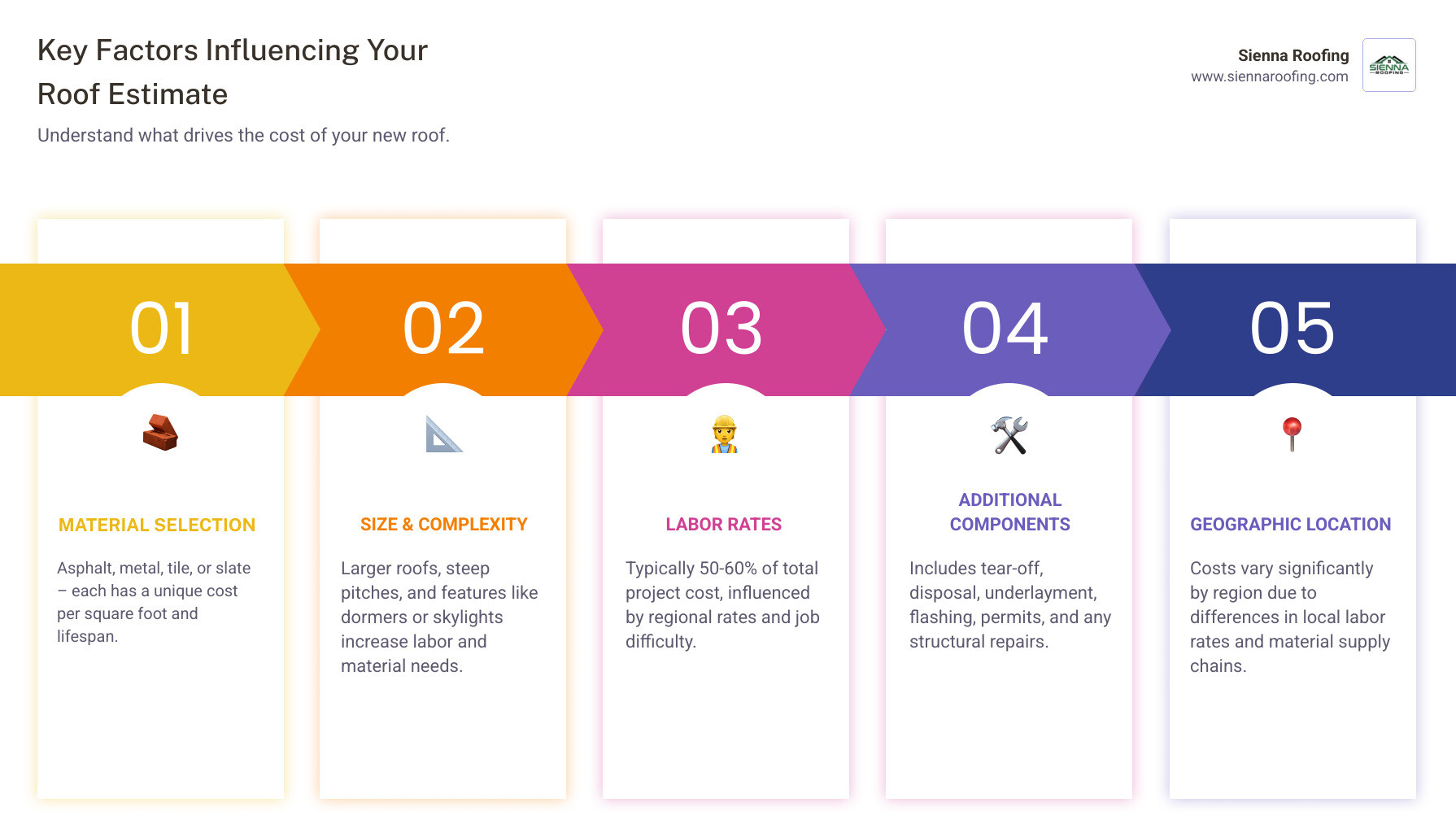
The Big Picture: Average Roof Replacement Costs
Your roof is your home’s hardest-working protector, an umbrella against decades of Texas heat, storms, and whatever else Mother Nature delivers. A new roof isn’t just an expense; it’s an investment. According to the 2024 Cost Vs. Value report, an asphalt shingle roof replacement can recoup over 56% of its cost at resale. This means you’ll see a significant return on this investment when you sell your home.
Beyond the financial benefits, a new roof improves curb appeal and provides peace of mind. It’s hard to put a price on sleeping soundly during a thunderstorm, knowing your family is protected.
Understanding the Average Roof Estimate Cost
The roof estimate cost for most homeowners falls between $7,000 and $14,500, with the national average around $11,000. However, your actual cost will vary based on your specific situation. In Texas, factors like intense summer heat, hail storms, and local labor rates influence pricing. Fortunately, competition among local contractors often keeps prices reasonable.
Here’s what you can expect for common roof sizes:
A 1,500-square-foot roof using standard asphalt shingles typically runs around $7,158. For a 2,000-square-foot roof with the same materials, you’re looking at approximately $7,283 to $11,000.
These figures are a solid starting point, but every roof is unique. Your home’s architecture, material choices, and necessary repairs can shift these numbers. For more specific information on local costs, check our guide on what is the average cost of a new roof in Texas.
Roof Replacement Cost by Square Footage
In roofing terminology, contractors use a unit called a “square,” which equals 100 square feet of roof area. A 2,000-square-foot roof is 20 squares. This standardized measurement helps contractors provide accurate estimates.
Most asphalt shingle roof replacements cost around $7 per square foot, but this can vary. Here’s how roof estimate cost breaks down by size:
- 1,000 sq ft roof (10 squares): approximately $5,573
- 1,500 sq ft roofs (15 squares): average around $7,158
- 2,000 sq ft roofs (20 squares): run about $7,283
- 2,500 sq ft roofs (25 squares): can expect around $7,686
- 3,000 sq ft roofs (30 squares): average approximately $8,519
Notice the cost per square foot decreases as roof size increases? This is because fixed costs like permits and setup are spread across a larger project. For smaller projects, our guide on how much it costs to replace 1000 sq ft of roof provides more detail.
These are baseline estimates. If your home has multiple levels, steep pitches, or features like dormers and skylights, the roof estimate cost will increase.
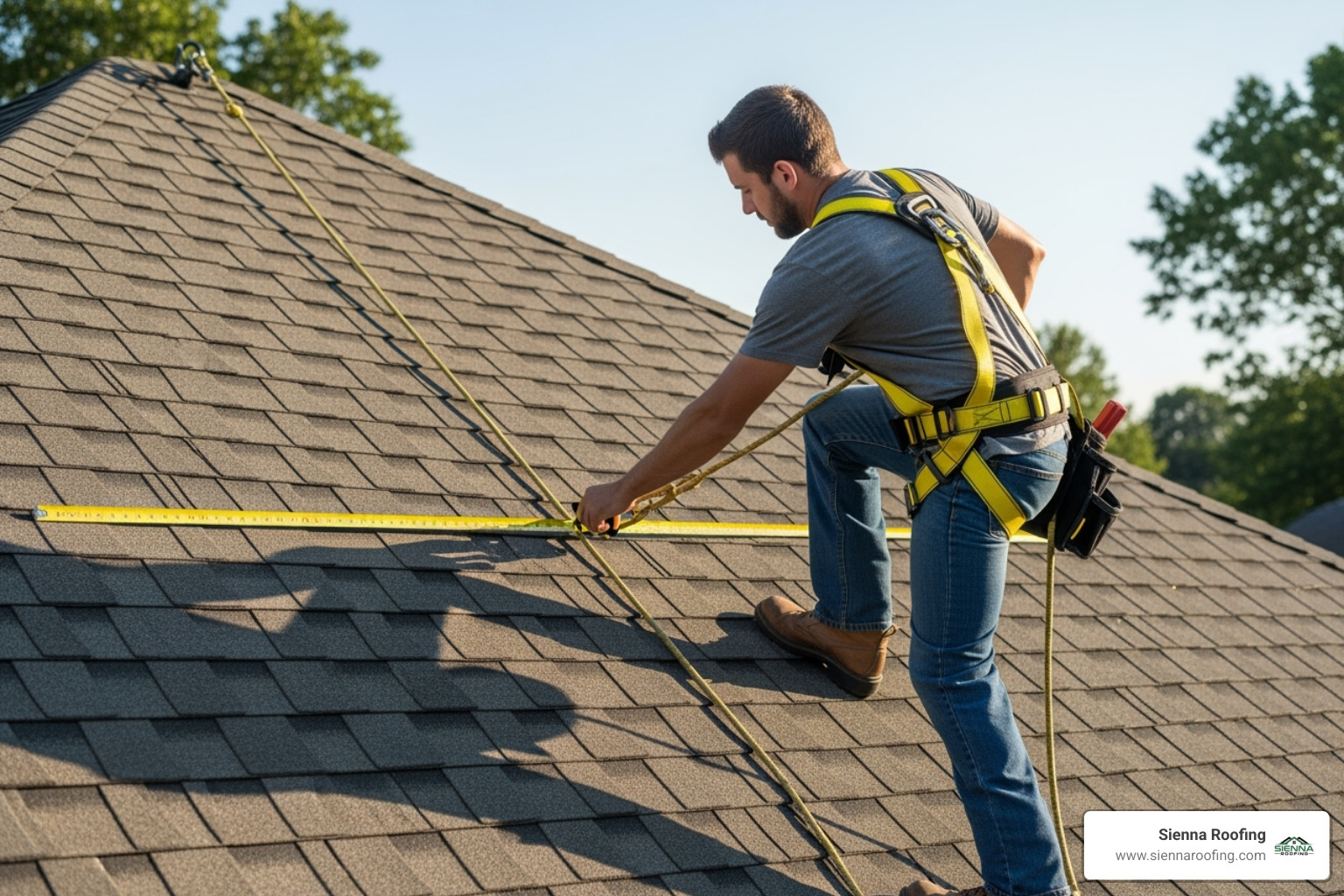
Key Factors That Influence Your Roof Estimate Cost
Much like baking a cake, a roof replacement involves various ingredients that determine the final price. Your choice of materials, the complexity of your roof, and labor rates are the primary variables that shape your roof estimate cost. This section breaks down the variables that determine your final price.
How Roofing Materials Impact the Price Tag
The material you choose is often the single biggest factor in your overall roof estimate cost. Each has its own price point, lifespan, and aesthetic. It’s not just about the upfront cost; it’s about long-term value, durability against Texas weather, and maintenance needs.
Here’s a detailed breakdown of common roofing materials and their typical installed costs per square foot:
-
Asphalt Shingles: The most popular choice in North America due to their excellent balance of affordability, performance, and versatility.
- 3-tab shingles: $3.50 – $5.00/sq ft. These are the most basic option, made from a single flat layer. They are lightweight and inexpensive but have a shorter lifespan (15-20 years) and lower wind resistance.
- Architectural (or Dimensional) shingles: $4.46 – $7.50/sq ft. The most common choice today. They are constructed with a heavier base mat and multiple laminated layers, creating a thicker, more durable shingle with a textured, dimensional look. Their lifespan is significantly longer (30-35 years), and they offer superior wind and impact resistance.
- Premium/Designer shingles: $6.50 – $8.50/sq ft. These shingles mimic the appearance of high-end materials like slate or wood shakes but at a fraction of the cost. They offer the best durability and aesthetic appeal within the asphalt shingle category.
- Average total cost: $7,000 – $14,000.
-
Metal Roofing: Known for exceptional longevity, energy efficiency, and durability. The upfront cost is higher, but it can save on energy bills and last a lifetime.
- Corrugated steel (exposed fastener): Starts around $4.00/sq ft. These are panels where the screws are visible, making for a faster, less expensive installation.
- Standing seam (concealed fastener): $7.00 – $16.00/sq ft. This premium system uses hidden clips and fasteners, which allows the metal to expand and contract with temperature changes, reducing stress and creating a sleek, modern look. It is considered a superior, more weathertight system. Premium options like copper can exceed $40.00/sq ft.
- Average total cost: $7,500 – $40,000. (Lifespan: 30-70 years). Metal roofs are also highly fire-resistant and can lead to home insurance discounts.
-
Tile Roofing (Concrete, Clay): Offers a distinct aesthetic and excellent durability, especially in warmer climates like Texas. They are fireproof and resistant to rot and insects.
- Concrete/Clay tiles: $7.00 – $25.00/sq ft. Clay tiles offer a classic, color-fast look, while concrete tiles are more versatile and can be shaped to mimic wood or slate. Their primary drawback is weight; your home’s structure must be assessed to ensure it can support the load, which can add to the cost.
- Average total cost: $10,500 – $62,500. (Lifespan: 50-100 years)
-
Wood Shakes/Shingles: Provides a classic, rustic look but requires more maintenance and is not permitted in all areas due to fire risk. Many Houston-area municipalities have restrictions on wood roofing.
- Wood shakes: $7.00 – $15.00/sq ft. They require periodic treatments to prevent moss, mold, and rot. While beautiful, their susceptibility to fire and moisture makes them a less common choice in modern construction.
- Average total cost: $12,900 – $28,200. (Lifespan: 20-35 years)
-
Slate Roofing: The pinnacle of roofing materials—incredibly durable, beautiful, and long-lasting, but also the most expensive and heaviest.
- Slate tiles: $10.00 – $30.00/sq ft. Slate is a natural stone that can last for over a century. It requires a reinforced roof structure and highly specialized installers, which significantly contributes to its high cost.
- Average total cost: $22,000 – $70,000. (Lifespan: 75-150 years)
Choosing a material isn’t just about the initial roof estimate cost; consider long-term value, maintenance, and how it fits your home’s style.
The Role of Roof Size, Pitch, and Complexity
Beyond material, your roof’s physical characteristics significantly impact the roof estimate cost.
- Roof Size: Measured in “squares” (100 sq ft), a larger roof requires more materials and labor, increasing the cost.
- Pitch: This refers to the steepness of your roof. A low-pitch roof (nearly flat) is easy to walk on, but a steep-pitch roof (e.g., 8/12 or greater) requires specialized safety equipment, harnesses, and roof jacks. This slows down the work and increases labor costs significantly. Very low-slope or flat roofs also have unique, often more expensive, installation requirements to prevent water pooling.
- Complexity: A simple, rectangular gable roof is the least expensive to replace. Features like dormers, skylights, multiple chimneys, and intersecting rooflines add complexity. Each feature requires careful, time-consuming work to cut materials and install flashing correctly to create a watertight seal. This adds to both material and labor costs.
- Valleys and Hips: These are the angles where different roof planes meet. They require precise cutting and layering of shingles and underlayment to prevent leaks. The more valleys and hips your roof has, the more labor-intensive the job becomes, increasing the overall cost.
A complex roof with many angles or a steep pitch will have a higher roof estimate cost than a simple rectangular roof of the same size. For a deeper dive, see our article on how roof spread affects cost.
Understanding Labor Costs for a New Roof
Labor is a significant portion of your roof estimate cost, typically accounting for 50% to 60% of the total project.
- Percentage of Total Cost: The skill required to safely and efficiently tear off the old roof, inspect and prepare the decking, and install the new multi-component roofing system makes labor a dominant factor.
- Average Labor Rate: Labor costs for roofing typically range from $3.00 to $7.00 per square foot, or $200-$300 per roofing square. This rate can increase for more complex roofs or high-end materials that require specialized installation techniques.
- Tear-Off & Installation: Removing the old roof is labor-intensive and must be done carefully to avoid damaging the property. Installation requires skilled roofers to ensure every shingle is nailed correctly, flashing is perfectly sealed, and ventilation is properly installed for maximum durability.
- Regional Differences: Labor rates vary by location due to cost of living, local demand, and regulations. In major metropolitan areas like Houston, costs might be slightly higher than in rural areas, but competition among qualified contractors helps keep prices fair.
When you get a roof estimate cost, ask for a breakdown of labor versus materials to understand where your money is going.
Beyond Shingles and Labor: Uncovering Additional Costs
When planning your roof estimate cost, it’s crucial to look beyond the main items like shingles and labor. A complete roof replacement is a complex construction project with several additional costs that can surprise homeowners if not accounted for. This is why a professional roof replacement assessment is vital.
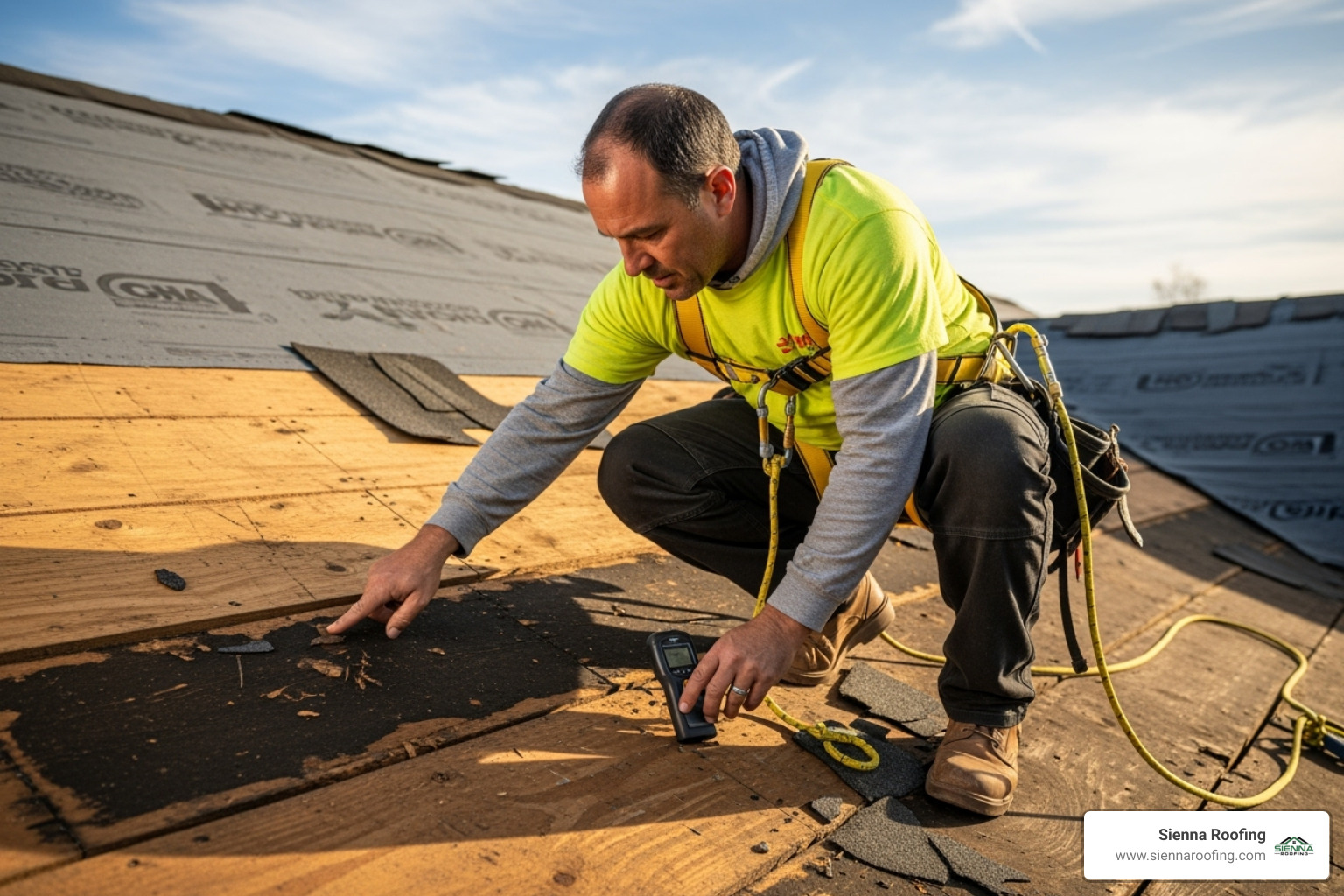
A comprehensive roof estimate cost should account for these additional expenses upfront. A reputable contractor will inspect your roof thoroughly, including the attic space, to identify potential issues before work begins.
Tear-Off, Disposal, and Structural Repairs
Before your new roof goes on, the old one must be completely removed. This is a critical step for a quality, long-lasting roof.
Old roof removal typically costs between $0.40 and $2.00 per square foot. The price depends on the material type (heavy tile costs more to remove than light shingles) and the number of existing layers. If a previous roofer installed new shingles over an old layer, both layers must now be removed, which doubles the labor and disposal costs.
Debris disposal involves the cost of a dumpster rental and landfill fees, which can range from $665 to $3,343 for an average-sized roof. This cost is almost always included in a contractor’s estimate.
Once the old shingles are off, the underlying roof decking (the plywood or OSB sheathing) is exposed. This is the only time to find and fix hidden damage. Roof decking replacement is necessary for any sheets that are soft, spongy, delaminated, or show signs of water damage. Replacing damaged decking costs between $2.20 and $3.00 per square foot and is essential for creating a solid, nail-able foundation for the new shingles.
In serious cases of long-term leaks, rafter repair might be necessary if water damage has compromised the roof’s structural frame. While uncommon, it requires immediate attention for your family’s safety and will add significant cost to the project.
These are realities of working with older roofing systems. For more on potential repair costs, check out our guide to roof repair cost.
Essential Components: Underlayment, Flashing, and More
Your roof is a system where every component must work together. While shingles get the attention, these supporting players often determine a roof’s true longevity.
- Underlayment: This water-resistant barrier is installed over the decking and under the shingles. It is the roof’s secondary line of defense against water intrusion. Modern synthetic underlayment, costing $1.50 to $2.10 per square foot, is far superior to old-fashioned felt paper, offering better tear resistance and water protection.
- Ice and Water Shield: Even in the Texas climate, this self-adhering membrane is invaluable. It is installed in the most vulnerable areas of the roof—valleys, eaves, and around penetrations—to seal out wind-driven rain. It costs $1.87 to $2.53 per square foot, plus installation.
- Flashing: These pieces of metal (usually aluminum or galvanized steel) are installed anywhere the roof meets a vertical surface, like a chimney, wall, or skylight. They direct water away from these critical joints. Poorly installed flashing is the number one cause of roof leaks. Quality installation costs $9.00 to $11.00 per linear foot.
- Pipe Boots: These pre-formed sleeves seal around vent pipes. They cost $63.00 to $85.00 each and are a small investment that prevents some of the most common types of leaks.
- Drip Edge: A metal flashing installed at the edges of the roof to direct water into the gutters and away from the fascia. It also protects the edge of the decking from water damage.
- Fascia and Soffit: These are the boards along the roofline and under the eaves. If they show signs of rot or water damage, they may need to be replaced. Fascia boards cost $4.25 to $8.62 per linear foot, while soffits run $2.80 to $5.28 per linear foot.
Ventilation and Permits
Two final, critical elements of your roof estimate cost are ventilation and permits.
- Ventilation: A properly ventilated roof is essential for its longevity and your home’s energy efficiency. A balanced ventilation system allows cool, dry air to enter through intake vents (at the soffits) and pushes hot, moist air out through exhaust vents (at the ridge or peak). This prevents heat buildup in the summer, which can bake shingles from the inside out, and prevents moisture condensation in the winter, which can lead to mold and rot. A lack of proper ventilation can even void your shingle manufacturer’s warranty.
- Permits and Inspections: Most municipalities, including those in the greater Houston area, require a building permit for a full roof replacement. This ensures the job is done according to local building codes, which are in place for your safety. The contractor is responsible for pulling the permit, the cost of which (typically $150 – $500) should be included in your estimate. The city may also require one or more inspections during the project to verify compliance.
Making Smart Decisions: Repair, Replace, and Save
Deciding between a minor repair and a full replacement can be daunting. The wrong choice could mean wasting money on a temporary fix or replacing a roof that still has years of life left. This section provides actionable advice to help you evaluate your options, save money without cutting corners, and find a reliable contractor.
Roof Repair vs. Full Replacement: When to Choose Which
Your roof estimate cost will vary dramatically depending on which path you choose. Understanding the key indicators will help you make a sound financial decision.
Repair is often the best option for:
- Younger Roofs: If your roof is less than 10-15 years old and is otherwise in good shape, a repair is usually sufficient.
- Localized Damage: Issues confined to a small area, such as a few shingles blown off by wind, damage from a single fallen tree limb, or failed flashing around one vent pipe.
- Budget Constraints: A professional repair can be a cost-effective way to stop a leak and buy you several more years of protection while you budget for a future replacement.
Full replacement is the smart choice for:
- Aging Roofs: If your asphalt shingle roof is approaching or has surpassed its 20-year lifespan, it’s living on borrowed time. Replacement is more cost-effective than a cycle of recurring repairs.
- Widespread Issues: Look for signs across multiple roof slopes, such as extensive granule loss (you’ll see the black, sand-like granules in your gutters), shingles that are curling at the edges, cracking, or widespread algae staining.
- Significant Water Damage: If you see water stains on your ceiling or in your attic, it indicates a serious problem that may have already damaged the roof decking. A simple patch won’t solve the underlying issue.
- The 25% Rule: A common guideline is that if the cost of the repair is more than 25-30% of the cost of a full replacement, the replacement is the better long-term investment.
How to Save Money on Your Roof Replacement
Saving money on a new roof shouldn’t mean compromising on quality. A cheap roof is often the most expensive one in the long run. Here’s how to be smart about your roof estimate cost.
- Timing: If your replacement isn’t an emergency, schedule it during the off-peak season (like late fall or winter). Roofing contractors are busiest in the spring and summer after storm seasons. You may find more competitive pricing when they are trying to keep their crews busy.
- Get Multiple Quotes: Obtain at least three detailed, itemized proposals from reputable, local contractors. This allows you to compare not just the final price, but the specific materials, scope of work, and warranties being offered.
- Material Selection: Choose materials with the best long-term value. For example, upgrading from basic 3-tab shingles to architectural shingles costs more upfront but doubles the lifespan of your roof, saving you money over time.
- Check for Rebates: Ask contractors or check manufacturer websites for rebates on energy-efficient roofing materials. Some “cool roof” products may qualify for local or federal tax credits.
- Homeowners Insurance: If your roof was damaged by a specific event like a hail or wind storm, your insurance policy may cover a significant portion of the replacement cost. Have your roof inspected for storm damage.
- Financing: A new roof is a major expense. Many established roofing companies offer flexible payment plans to make the cost more manageable. Learn more about financing options for roof repair in Houston.
Finding a Trustworthy Roofing Contractor in Sugar Land, TX
Choosing the right contractor is the most important decision you’ll make. A trustworthy professional ensures your roof estimate cost is transparent, the work is high-quality, and your investment is protected.
- Licensed and Insured: This is non-negotiable. Ask for proof of general liability insurance and worker’s compensation insurance. This protects you from any liability for accidents or property damage during the project.
- Local Reputation: Look for a roofing contractor in Sugar Land, TX with a physical office, strong community ties, and a long history of positive online reviews on sites like Google and the BBB.
- Manufacturer Certifications: Top contractors often have certifications from major manufacturers (e.g., GAF Master Elite, Owens Corning Platinum Preferred). This means their crews are factory-trained in the best installation practices and can offer improved material warranties.
- Written Estimates: A professional estimate is a detailed document, not a number on a business card. It should spell out all material types, labor costs, tear-off and disposal fees, and warranty information.
- Strong Warranties: A quality roofer will stand behind their work. Look for strong warranties on both materials (from the manufacturer) and workmanship (from the contractor).
- Clear Communication: A good contractor will assign a project manager, communicate a clear timeline, and keep you informed about progress and any unexpected issues that arise.
For personalized, community-driven service, trust the experts at Sienna Roofing. We have been serving the Houston area with integrity and quality craftsmanship. Learn more about 7 signs that a roofing company in Sugar Land is trustworthy.
Sienna Roofing
17034 University Blvd, Sugar Land, TX 77479
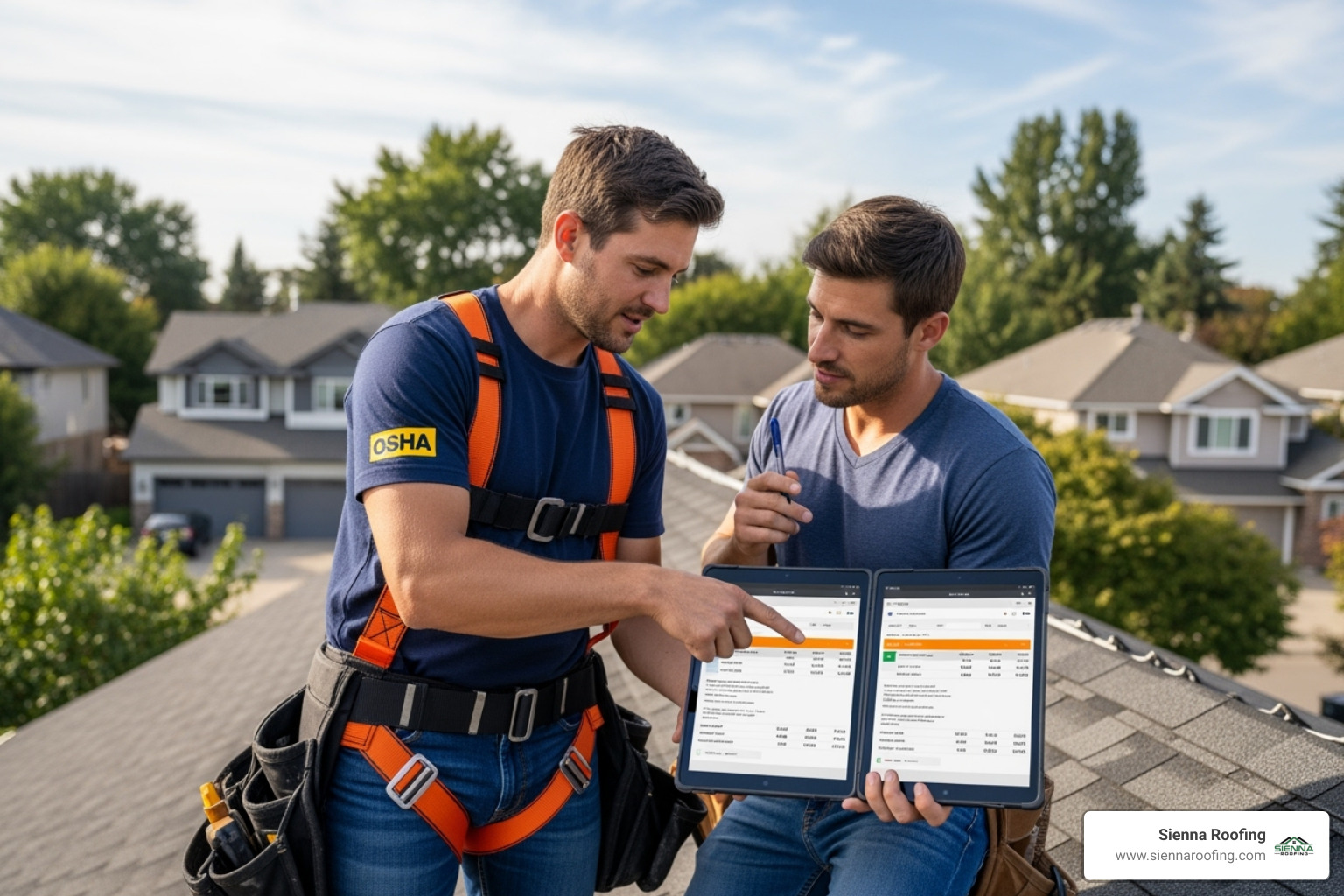
Frequently Asked Questions about Roof Estimate Costs
Homeowners should always ask questions about their roofing projects. A transparent contractor will be happy to provide clear answers. Here are our responses to the most common concerns we hear about roof estimate cost.
How much does a new roof cost for a 2,000 sq. ft. house?
For a 2,000-square-foot house, the cost depends heavily on your material choice and roof complexity. With standard architectural asphalt shingles, you can expect to pay approximately $7,200 to $12,000. This range accounts for different shingle qualities, local labor rates, and your roof’s specific features. A simple, low-pitched gable roof will be on the lower end of that range, while a steep, complex roof with multiple dormers and valleys will be on the higher end.
If you opt for premium materials, the roof estimate cost increases significantly. A metal roof might run $15,000 to $25,000, while a tile roof could reach $25,000 to $40,000 or more. Slate, the most premium option, could exceed $50,000 for a 2,000 sq ft home. The key drivers are always the cost of the material itself, the specialized labor required to install it, and the complexity of your roof.
Can I install a new roof over my old one?
This practice, known as a “roof-over” or “layover,” is technically allowed by some building codes if there is only one existing layer of shingles. It saves money by avoiding the cost of tear-off and disposal. However, we strongly advise against it. A full tear-off is the only way to do the job right. A roof-over adds immense weight to your roof structure, traps heat and moisture that can accelerate rot, and prevents the roofer from inspecting the underlying roof deck for damage. Most importantly, nearly all shingle manufacturers will void their warranties if their product is installed over old shingles. The small upfront savings are not worth the long-term risks and potential for premature failure.
What should a detailed roof estimate include?
A professional estimate is much more than a single price. It should be an itemized document that allows you to compare quotes accurately. Look for these key elements:
- Scope of Work: A clear description of the project, including full tear-off of old roofing, installation of the new system, and site cleanup.
- Materials: The specific manufacturer and product names for all components (shingles, underlayment, ice and water shield, starter strips, ridge caps).
- Itemized Costs: A breakdown of costs for materials, labor, and debris disposal.
- Contingency Costs: A stated price for potential wood decking replacement (e.g., cost per sheet of plywood), so there are no surprises if damage is found.
- Permit Fees: The cost of pulling the required municipal building permit.
- Warranty Information: Details on both the manufacturer’s material warranty and the contractor’s workmanship warranty.
- Payment Schedule: A clear outline of when payments are due.
Does a new roof increase my home’s value?
Absolutely. A roof replacement significantly increases your home’s value in multiple ways. First, there’s curb appeal; a fresh, modern roof makes a home look newer and better maintained, creating a powerful first impression for potential buyers.
Beyond looks, a new roof improves energy efficiency and provides crucial structural integrity. According to recent industry reports, homeowners typically recoup over 56% of their roof replacement cost at resale. A new roof also removes a major point of negotiation for potential buyers, who know they won’t face a large roofing expense for many years. Because of this, homes with new roofs often sell faster and closer to the asking price.
How long does a typical roof replacement take?
Most residential asphalt shingle roof replacements are completed in one to three days. Several factors influence this timeline:
- Roof Size and Complexity: A straightforward, 1,500 sq. ft. ranch-style home might be done in a single day. A large, 3,500 sq. ft. two-story home with a steep, complex roof could take three days or more.
- Material Choice: Asphalt shingles install relatively quickly. Heavier materials like tile or specialized systems like standing seam metal require more precision and can take longer.
- Weather Conditions: For the safety of our crew and the quality of the installation, work will pause for heavy rain, strong winds, or extreme heat. We always keep you informed of any weather-related delays.
- The Process: A typical project involves Day 1 for material delivery, property preparation (tarps, etc.), and the full tear-off. Day 2 is often for any necessary decking repairs and installation of the new underlayment and shingles. Day 3 may involve finishing details, ridge caps, flashing, and a thorough final cleanup.
Your contractor should provide a specific timeline with your roof estimate cost.
Conclusion
Understanding your roof estimate cost is the most critical part of planning a new roof. It’s your roadmap for making one of the most important investments in your home. When you know the key factors—from materials and labor to vital components like flashing and underlayment—you can compare quotes effectively and choose a contractor who offers true value, not just the lowest price.
A new roof is a major investment in your home’s safety and value. Armed with the knowledge from this guide, you are prepared to ask the right questions and make an informed choice that protects your family and your wallet.
The difference between a cheap estimate and one that reflects quality work lies in the details: proper tear-off, quality components, skilled labor, and comprehensive warranties. These are essentials that ensure your new roof performs as it should for decades. A replacement done right the first time saves you money and stress down the road.
For a personalized and accurate estimate for your Houston-area home, trust the experts at Sienna Roofing. We believe in transparency and quality craftsmanship. Get your free, no-obligation roof estimate today!
